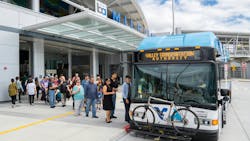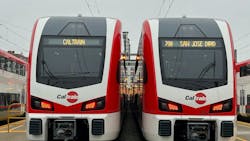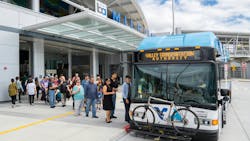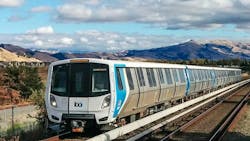Bay Area transit agencies are working to improve and apply synced scheduling to align transfers and connections between systems for a better rider experience. The responsibility of keeping regional and local services running smoothly and on time falls upon Bay Area Transit schedulers, planners and general managers, who constantly work to establish regional and local schedules that adapt and accommodate current events and ridership needs.
Local transit reliability and stability was tested in the height of the COVID-19 pandemic, as Bay Area transit agencies saw their ridership levels drop. During this time, riders were asking the agencies to implement better transit schedules. Local transit providers like Santa Clara Valley Transportation Authority (VTA), Alameda-Contra Costa Transit District (AC Transit), Bay Area Rapid Transit (BART), and 24 other Bay Area transit agencies came together to officially discuss the need for one synchronized schedule that incorporated the needs of each agency and their ridership. The idea set forth a series of meetings and planned programs that have helped to introduce better scheduling methods, along with stronger communication between neighboring agencies in the area.
Trust the process
Planning out a synced transit schedule is a process in itself. A schedule change is planned months in advance through weekly meetings between agencies, commented Santa Clara VTA Service Planning and Scheduling Manager Jay Tyree. Planning for the most recent schedule change for Santa Clara VTA, which came out the week of Aug. 12, 2024, began in March of this year.
“All the operators get in a room every time we talk about the schedule changes coming up and we discuss what can be moved, what issues we each have and we work through them,” Tyree said.
This method of programming and scheduling for transit services has gained the interest of other agencies in the area. There has been a 250 percent increase in the number of transit agencies changing their schedule concurrently twice each year and six of seven major transit providers in the Bay Area are syncing their schedule changes at least once a year. Through this collaboration, neighboring regional service partnerships have been strengthened and agencies are taking a closer look at what can be improved or improvised within its system.
Santa Clara VTA
The Santa Clara VTA has altered its scheduling to match BART and Caltrain’s schedule changes, which will work towards ensuring timed transfers are maintained at various locations across the South Bay and Peninsula.
The agency is working to address ridership needs by monitoring ridership levels at certain connection points within its system.
“Transit centers that connect with Caltrain or BART or our neighboring services like Sam Trans are monitored for ridership changes over time to see what routes connections are important at,” Tyree noted.
As part of making changes to its ridership service experience, Santa Clara VTA is also working to improve its operator training methods. The agency is focusing efforts on stronger courses and lessons to increase its output of operators through its training sessions. The agency is seeing a full staff on bus operators but is in search of light- rail operators to help keep services running and on time.
The agency will begin surveying its ridership in September to gage ridership satisfaction with the new transit schedule in place. Any feedback will be used in future contributions to schedule change talks.
AC Transit
Another change that was implemented through the recent schedule sync included AC Transit and Golden Gate Transit’s more coordinated and improved schedules at El Cerrito del Norte Station and along Cutting Boulevard west of the BART station. The alignment will enhance reliability for riders traveling between Marin and West Contra Costa, Calif., counties via the Richmond-San Rafael Bridge. In this iteration, the two agencies focused on coordinating transfers for AC Transit’s Line 76 and Golden Gate Transit’s lines 580 and 580X.
The transfers would allow a rider traveling southbound on Line 76, looking to transfer westbound across the Richmond-San Rafael Bridge via Line 580X, to no longer have to face a near-miss for the transfer at key times.
“With the new coordinated schedules, the departures are now staggered, reducing the wait time for westbound riders to approximately 10 minutes instead of 15 minutes during most of the operating day,” said AC Transit Media Affairs Manager Robert Lyles. “AC Transit aims to achieve even greater improvements for riders by the end of the year. Ultimately, this alignment improves reliability for riders traveling between Marin and West Contra Costa counties via the Richmond-San Rafael Bridge.”
The new schedule changes to AC Transit have also helped to promote faster rider boarding on southbound Line 76 rider at Harbour Way and Cutting Boulevard, specifically during the morning peak. AC Transit reports that riders previously had to wait 27 minutes for the next westbound Line 580 or 55 minutes for the next westbound Line 580X. With the new coordinated schedules, the wait time has been reduced to seven minutes for the next westbound Line 580X. Similar wait time improvements are being realized for southbound Line 76 riders boarding at Harbour and Cutting.
In the afternoon peak, a southbound Line 76 rider boarding at 6:31 p.m., 7:30 p.m. or 8:27 p.m. at Harbour and Cutting previously faced near misses or missed connections to the westbound Line 580, with waits of 53 to 57 minutes for the next westbound Line 580 if a connection was missed. With the new coordinated schedules, if the rider misses a transfer, the wait time is now significantly reduced to between 13 and 17 minutes.
BART
BART is also a major player in this program to sync transit service schedules. Being one of the bigger regional transit providers in the area, BART has always shared its schedules with neighboring agencies such as Caltrain and Santa Clara VTA. Its upcoming changes to some of its rail transfers at Millbrae Station will go into effect when Caltrain launches its electric service on Sept. 21. With BART’s schedule change that went into effect on Aug. 12 and Caltrain’s schedule change that begins on Sept. 21, approximately 85 percent of all weekday trains will have a transfer between five and 19 minutes at Millbrae Station. On the weekend, approximately 90 percent of trains will have a transfer between five and 19 minutes, BART notes. If trains were scheduled with less than a five-minute wait, delays would frequently break the transfer and result in a longer wait.
Schedule syncing isn’t a new idea to the transit industry. It can be hard to step away from something that has worked in the past to accept something that could make things better. Participating transit agencies have embraced the idea of change to invite a bright and more efficient future for local transit.
Even after the most recent schedule change, Bay Area transit agencies are still coming across issues that challenge them to find efficient solutions to improve rider experience.
Some of the issues Bay Area transit agencies are still seeing include:
- A better transfer for one end of a route may create a worse transfer for other areas of the route
- Adding service to allow frequencies to match each system requires new funding at a time transit agencies are facing significant budget challenges
- Transfers between BART and Caltrain at Millbrae Station don’t always line up perfectly because Caltrain has four trains per peak hour and two trains per off-peak hour/weekends. BART has three trains per hour at all times. Both systems are also limited in flexibility due to key system timing points elsewhere
The 27 agencies are currently planning for the upcoming schedule changes in January 2025. The coordinated schedule changes will help to benefit current transit riders while attracting new riders. The ultimate goal is to increase ridership by making transit more attractive and easier to use through one “Big Sync”.
About the Author
Eman Abu-Khaled
Associate Editor
Eman Abu-Khaled is a former associate editor with Mass Transit magazine.




